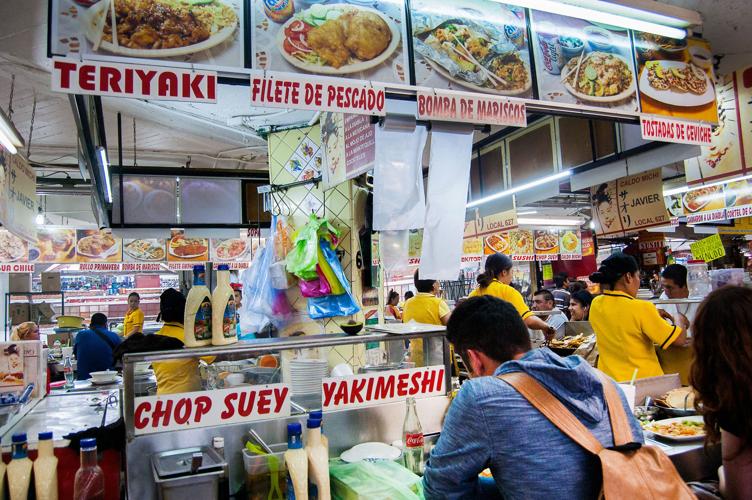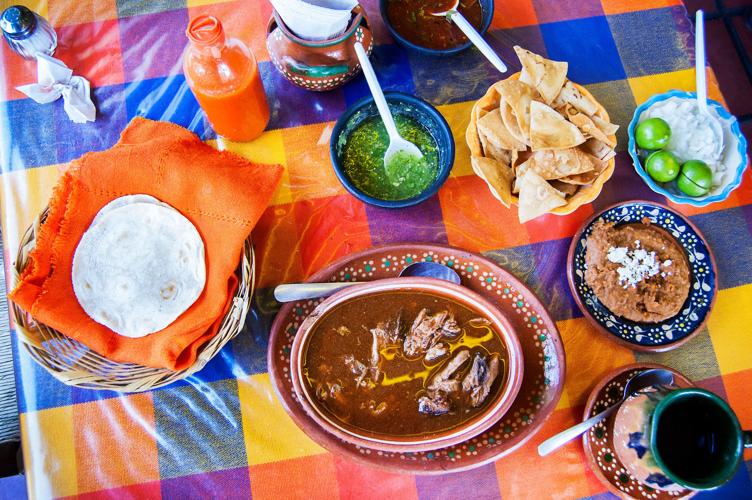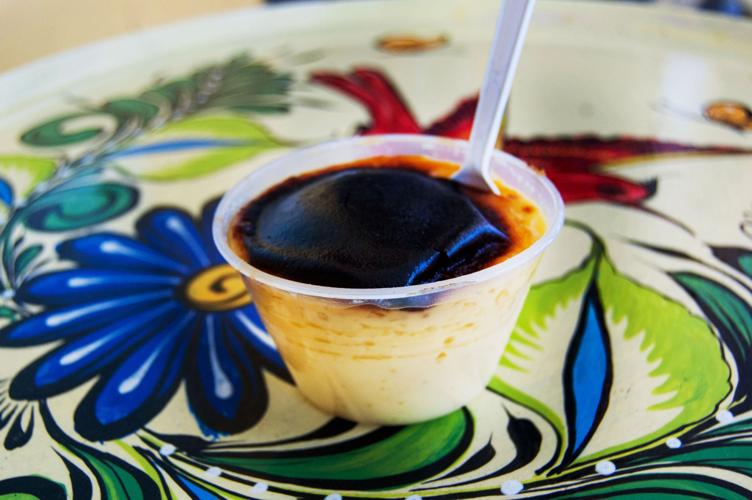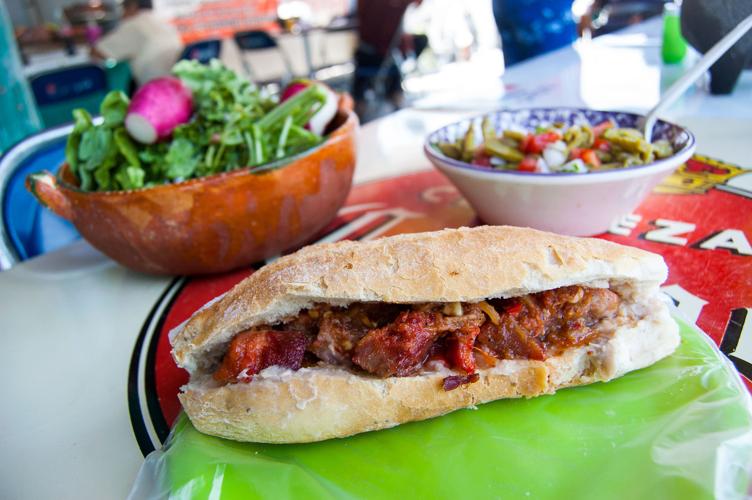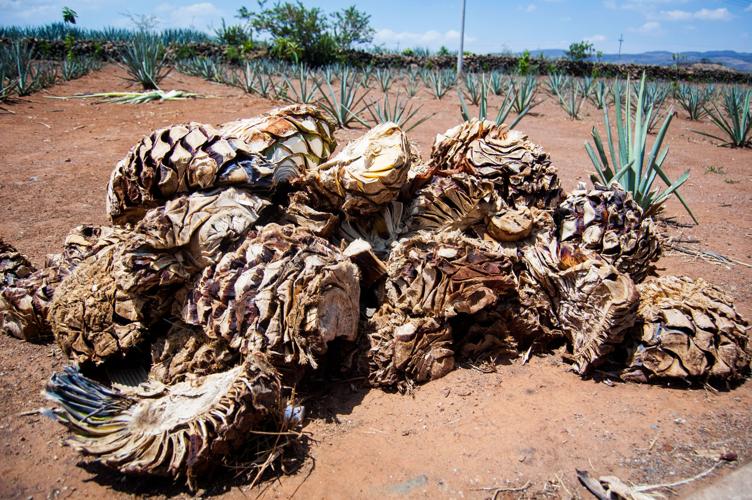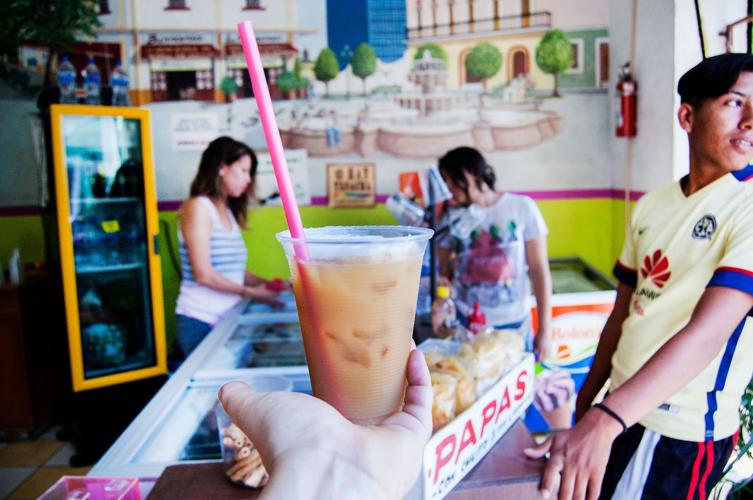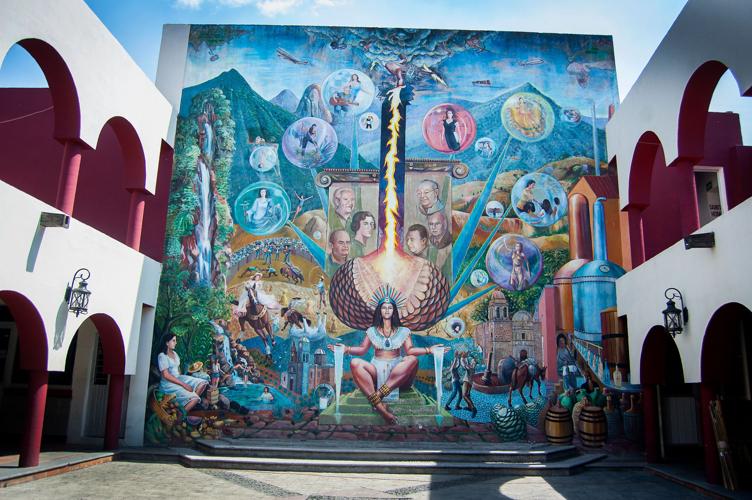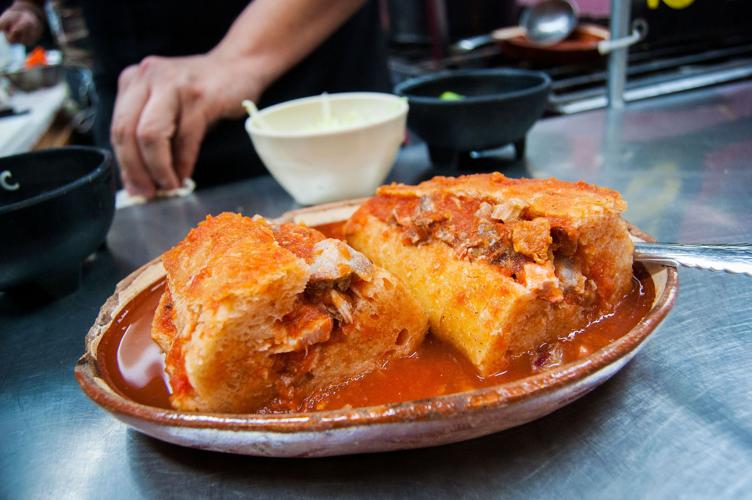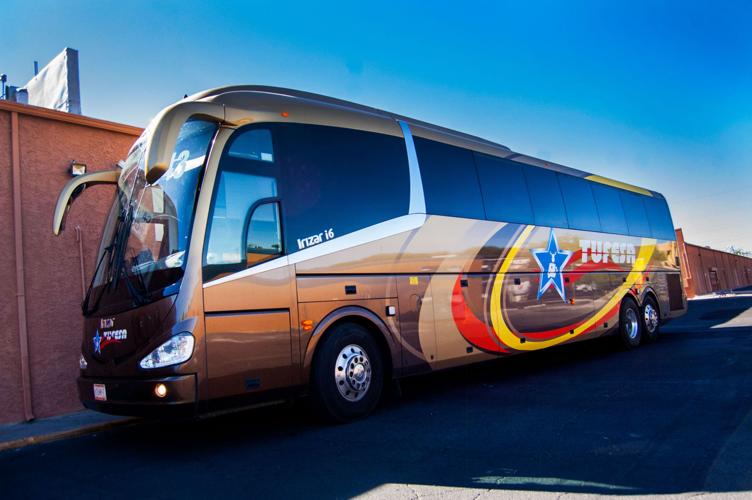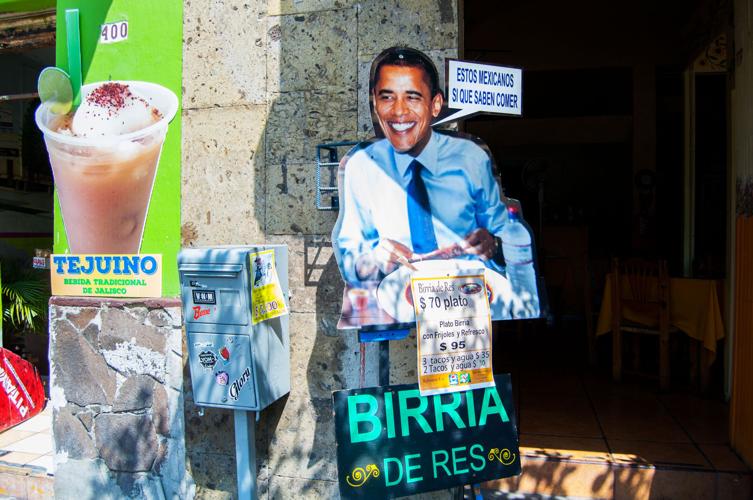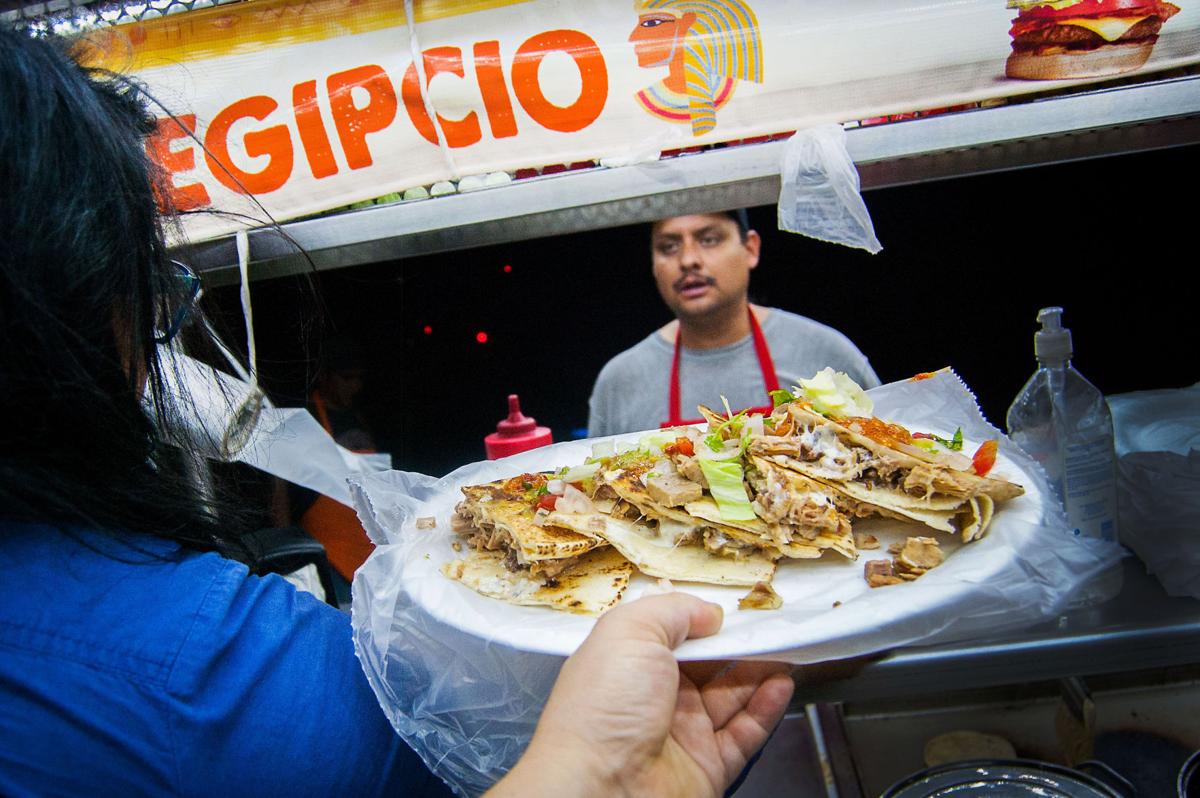"Yo estoy tranquilo porque al fin de cuentas, En nuestro idilio, las pencas hablan." - Vicente Fernández
The priest was drowned out by mariachi music, which tooted up through the open doors of the 18th-century church as he gave his closing prayer. He did not look annoyed, or even surprised at all, but just went on solemnly until he was done and the only words you could hear were a serenade, which I followed down the steps to the street below.
It was here in the stony Plaza de los Mariachis that my trip to Guadalajara officially began, I'm guessing ... since I walked into a bar and received an epic tanker of a michelada while a bowtied man sang to me. But it had taken two days to get to this point.

It was called huamuchil (monkeypod) by vendors at the daily pitaya market near the Plaza of 9 Esquinas. It is a technically a pea, but it's sweet and people eat it like a fruit.
Most Tucsonans might choose to fly directly to the City of Roses through the Mexican airline Aeromar, which now runs five days a week for under $400 round-trip. But my vacation plan was far cheaper and significantly more complicated.
It started out simple enough, that I would drive the full length of the U.S.-Mexico border in my 2010 Toyota Yaris I'd named Wensleydale, after an English cheese. This was deemed too dangerous. So I ditched the car idea and switched to buses, then turned my eyes south toward Guadalajara. (More romantic than Brownsville, Texas.)

"Estos Mexicanos si que saben comer," says Obama. "These Mexicans sure do know how to eat."
Then there was the problem of the breakup. A year ago we'd been traveling across Spain for our 10-year anniversary, and since then I'd been having trouble remembering what life was supposed to be. Sometimes the days stretch out like a flat gray plain, with no grids or markers to give you direction.
Traveling has helped blast me out of that blankness, if only for a few days. So when I realized my "aloniversary" date was coming up, I freaked and I bought a quick flight out of Hermosillo, the capital of Sonora. It cost me $80 round-trip through the discount airline Viva Aerobus. (Although I had to say my duffel bag was my "personal item," and was charged $2.80 at the airport for not printing out my boarding pass.)
To get to Hermosillo I took a five-hour bus ride. I booked it through the Mexican bus line Tufesa, which leaves from a parking lot at 5550 S. 12th Ave. (FYI: There were website issues, so I had to go to the station to buy my ticket.) For this I paid $74, but I bought it last-minute. While in Hermosillo, I saw a sprawling mural, ate giant chimichangas and stayed at the budget hotel Ibis, which was clean and a steal at $37 a night. If you save your money, you can even buy some raw steaks inside the gate at the airport, to take with you on the plane.

Tufesa serves the state of Sonora and has routes all the way down to Guadalajara. I took my bus to Hermosillo and then got on a plane.
I do not recommend this approach for casual travelers, or people without any Spanish skills. But I mention it because Hermosillo has become a gateway for me now. A quick search from Skyscanner: Hermosillo to Mexico City, $206. To Oaxaca, $271. To Cancun, $245.
It sounds a little ridiculous all typed out like this. But physically driving across the border made Guadalajara less of a "destination," and more of a real place for me. It is a very different Mexico I saw here. It is the Mexico of Spain, of stoneworked palaces and sidewalk cafes ... until you peel back the layers and find the sloppy sandwiches, and the masked wrestlers, and the tequila.

Drinking cantaritos with new friends in the city of Tequila. A cantarito is a tequila cocktail with citrus and grapefruit soda, served in a clay cup.
Spanish colonists founded Guadalajara in 1542 in the Valley of Atemajac, which was previously inhabited by various native tribes including the Tecuexes and Cocas. As the capital of Nueva Galicia, it had considerable riches and influence, which you can see in ornate buildings throughout the "centro," or downtown area. I stayed there, in a cheap hostel called Hospedarte ($10 a night).
My goal was to eat all of Guadalajara's iconic foods, which include soups like red posole and the beefy carne en su jugo, as well as a flan-like dessert called Jericalla that was invented by nuns who worked in an orphanage that looked like a castle. Of course, the most well-known dish is the famous drowned sandwich, the torta ahogada.

A torta ahogada at the San Juan de Dios market comes smothered in a pungent sauce made from chiles de árbol.
Tortas are different here than they are anywhere else. First of all, they are called lonches, unless you get them smothered in chile sauce as a torta ahogada. Guadalajara is a city of bread, salty and crusty sourdough that the locals call "birote." In the 1860s the city was occupied by the French, as well as a Belgian sergeant named Camille Pirrotte, who spread the gospel of baguettes.
The historic centro was littered with these sorts of sandwiches, and I had one on my very first day. It was at a cafe called Ay Tacos near the mariachi plaza, bedecked by a spinning trompo of al pastor chile pork. I got my lonche with al pastor, and it came with slivers of red onions on the side. Freaking tasty, and only 30 pesos or $1.68.
The next day I attempted to find more in the sprawling San Juan de Dios market, a must-see for any foodie. But I got sidetracked on my way, and ended up in the quaint 9 Esquinas neighborhood behind a major downtown thoroughfare. I settled in at an open-air restaurant Birrieria 9 Esquinas that specialized in Jalisco's masterpiece, goat birria, which they steamed for hours in agave leaves until the meat was incredibly tender. There were faint spices of cumin and clove in the broth, but it was so subtle and delicate ... unlike any beef birria I've had up here.

Handmade corn tortillas and a plate of birria de chivo will run you about $5.50 at Birrieria 9 Esquinas.
I walked a few yards and found a shop that specialized in the Mexican sorbet nieve de garrafa, and was handed a frosty cup of Tejuino (my new favorite drink)! It's a fermented corn beverage that's sweetened with piloncillo and rounded out with some tangy lime. The "drink of the gods" was around before the Spanish got here, but I liked what this lady did by throwing in lime sorbet. Later at the gates of Guachimontones I tried a Tejuino with beer, kinda like a chelada. So refreshing.

Tejuino is sold in stores across Guadalajara, but for some reason it hasn't much made it up to AZ.
Oh yeah, the market ... What a fever dream that was. It's a little hidden, but you'll know you're there when you see the shoes. Rows and rows of colorful huaraches, visible from the street. You sort of dive into them, and then down some dimly-lit corridors until you pull through into an open-air plaza. Here is where you grasp the immensity of what you're about to see.

A sugarcane juice stand in the central plaza of the San Juan de Dios market.
To enter the San Juan de Dios market, you descend into a basement-level maelstrom, a labyrinth of windowless corridors packed with people and stuff. A post-apocalyptic sci-fi is what it's like, except the exotified culture is Mexico instead of Asia, and people are hawking perfumes, leather saddles, miniature clay bananas, etc. "Que buscabas? Que buscabas? Que. Buscabas!!!"

The food stalls at the San Juan de Dios are much like this: They all have really cool pictures.
The food area is unbelievable. But much of it, surprisingly, is Chinese and Japanese stir fries. People eating sushi. I got a little overwhelmed at this point trying to make a decision, so I sat down at the nearest place and got some flautas. The woman didn't fry them for me, she just picked them up from the display. I tried again. Torta ahogada this time, from a place one level down. I won't go into it, but the meat was cold and had no flavor.
I had to go lay down for awhile. (Which is saying a lot, when you're staying at a hostel.) I re-emerged in the evening and hit up some bars in the trendy Chapultepec neighborhood. Drinking is strange, when you're alone. You go from place to place to take up time and give yourself something to do. An upscale food hall, a metal bar, an Irish pub ... And then, I found the Arab tacos. (Pictured up top.)
What are Arab tacos? They're quesadillas with pita bread, basically. Tacos Arabes were invented by Middle Eastern immigrants in the city of Puebla, which is very far away from here. The owners of this late-night stand were from Egypt, and they used a spongy white cheese that melted beautifully into the chopped beef ribs tucked inside.

This mural in the central plaza of Tequila depicts, I dunno, the story of tequila? you tell me!
The next day I went on a tequila tour and visited a distillery Tres Mujeres in the nearby city of — wait for it — Tequila! (You know where they invented it and stuff.) I booked this through my hostel for $25, but here's a handy link if you wanna plan ahead.

A pile of agave hearts at the Tres Mujeres distillery in Tequila.
I won't bore you with the details of how beautiful the rows of agave were, añejo vs. reposado, or how they play Beethoven 24-7 for the aging tequila, etc. But I will say the tour was fun. I met guy from Morelos, Mexico who liked to drink, and afterwards we went to a packed nightclub called Salmon and he suggested ordering six beers at a time. (It was hard to get to the bar.) "Cabeza clara, cerveza obscura," he said. At the end of the night, he leaned over to whisper in my ear, and told me he was the devil.
I don't have any photos from this night, fortunately. But the next day I was a little out of commission foodwise, although I was able to travel on a public bus to an archaeological site 50 miles away. Even the salty potato chips I bought from a street seller on the walk back sent me running toward the hostel though.

These aren't the chips I was talking about. (I didn't take a picture of those.) This is a cup of elote at a stand in Tlaquepaque.
On the last day I got into a car accident. I was heading by taxi to the nearby town of Tlaquepaque, famous for its artisan crafts. We were in one of those giant roundabouts where everyone is going 20 million different ways, and a bus slammed into us and took off the rearview mirror. My cab driver hauled ass and blocked the bus, then got out and started screaming "Pagueme!"
The whole thing was over before I had taken ten steps out of the car. The driver called me back, and said that he had been paid. A few hundred pesos. He took the loss.
Back in the car, he recommended I skip the overpriced restaurants of Tlaquepaque and find the town market. "That's where the real food is," he said. I didn't fully trust him at this point. But he was a nice guy, so I looked around there first, and then kept going out of the touristy district to what looked like a typical Mexican city, with bodegas and tortilla shops and all.

I found this Jericalla at the central market of Tlaquepaque. It tasted like flan, but it had a crispy burnt top much like a creme brulee.
I was drawn into Tacos Don Vic by the glazed pottery bowls of fresh radishes and their verdant green leaves. It was a little sidewalk stand with a tent, overlooking a nearby plaza. (I don't really know how to tell you to get there, so I guess it'll remain mysterious and beautiful forever.)
They made me up a lonche with bread from a little basket next to the produce stand. It was some of the most incredible, crusty bread I've had in recent memory. And the "pancita" meat, taken from one of the clay pots on the stove, tasted distinctly like Chinese barbecue pork. It was fantastic. There was no chile sauce or red onions like before, just a side of the typical pico de gallo here, studded with nopales cactus peddles.

This is the best thing I ate in Guadalajara. Except I guess technically it was in Tlaquepaque.
I felt accomplished on the plane back to Hermosillo. I had survived. I didn't seem to be cursed, and I had eaten three different sandwiches. To celebrate I spent the night holed up in the hotel room eating a ribeye steak with beans and chimichurri sauce from a styrofoam box while watching a wizard show dubbed into Spanish.
The next morning I had half an hour before I needed to be at the Tufesa bus terminal, and the hotel restaurant was closed. The staff suggested I get breakfast down the street at Palominos. I walked in, wearing cutoff jeans and a screenprint shirt with a cartoon picture of the Salt Bae that said, "Mas sal, mijo." There was nobody in the restaurant, but there were a whole lot of servers.
They beckoned me to sit down, and brought over a stand-up coat hanger for me to hang my duffel bag on. It was a white tablecloth restaurant, very fancy. Then they handed me the menu. It was all steaks.
I looked around and realized all the tables were reserved for different parties who were arriving at 1 p.m. Oh my goodness, it was Father's Day. Extremely well-dressed people began to stream in with their families and their young children. I ate my pie and drank my coffee alone at my table. And all of the sudden, I felt really selfish.
You see I had to turn off my phone to save money, so I hadn't called my dad or anyone since I left the U.S. Here I was in Mexico, trying to find myself again. But who was trying to find me?



